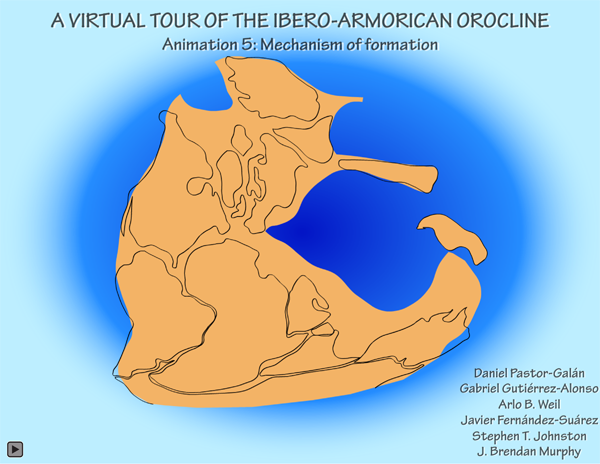What caused the Ibero Amorican Orocline?
Available structural, geological, geochemical and geophysical data are consistent with the Ibero-Armorican orocline developing by buckling of an originally linear orogen (Weil et al. 2000, 2001, 2010; Gutiérrez-Alonso et al., 2004, 2008, 2011a,b, Martinez-Catalan, 2011). Iberia was positioned close to the center of the Pangea supercontinent during orocline formation. The eastern margin of the supercontinent was characterized by a westward-tapering Paleo-Tethys oceanic embayment which apex was Iberia (first image in Animation 5). The Paleo-Tethys is inferred to have been characterized by an E-W trending mid-ocean ridge, a north-dipping subduction zone along its northern margin that descended beneath the Laurasian portion of Pangea, and a passive southern margin on the Gondwanan portion of Pangea. This palaeogeography (first image in Animation 5) is the basis for a potential explanation for orocline formation. Subduction of the mid-ocean ridge beneath the Laurasian margin of Pangea, would have resulted in “self-subduction” (Gutiérrez-Alonso et al., 2008). After ridge subduction, oceanic lithosphere subducting beneath Laurasia would have been part of the Pangean plate, being attached to the opposing Gondwana passive margin of Pangea (Animation 5, 310 to 299 Ma). Because of the continuity of the oceanic lithosphere with the Gondwanan passive margin, slab pull due to northward subduction beneath the Laurasian margin of the Paleo-Tethys would have been transmitted into continental Pangea, resulting in a profound change in the Pangea stress regime (Animation 5, 310 to 299 Ma). The self-subduction strain would have been characterized by shortening and contraction within the inner region of Pangea that surrounded the western end of the Paleo-Tethys, and concomitant extension around the Pangea periphery. In Animation 5, we suggest that the contraction within the inner tract of the Pangea superplate gave rise to the Ibero-Armorican orocline, explaining the lithospheric delamination, mantle replacement and the ensuing magmatic activity. In contrast, Late Paleozoic radial rift basins characterize the periphery of northern Pangea, supporting the idea of widespread extension around the edges of the superplate. Slab pull subsequently resulted in failure of the continental lithosphere along the northern Gondwana passive margin, creating a rift basin south of and parallel to the southern Tethys margin (Animation 5, 299 to 270 Ma). Self-subduction ended with the formation of the Neotethys mid-ocean ridge, which detached continental Pangea from the subducting slab (see cross-section in Animation 5). This final stage is likely recorded in the widespread Permian-Carboniferous unconformity in the continental basins of Europe.
Animation - Animation 5.

Schematic animation showing a simplified Pangea reconstruction and schematic lithospheric cross-sections through Paleo- and Neothethys oceans from 320Ma. to 270Ma. The animations shows the mechanism proposed for the formation of the Ibero-Armorican orocline: the self-subduction of Pangean global plate. The animation stops twice: at 310 Myr ago, at the starting of the orocline formation; at 299 Myr ago, when the orocline is finished.